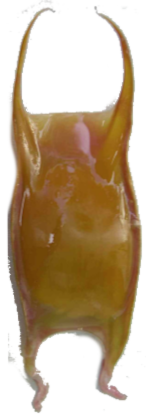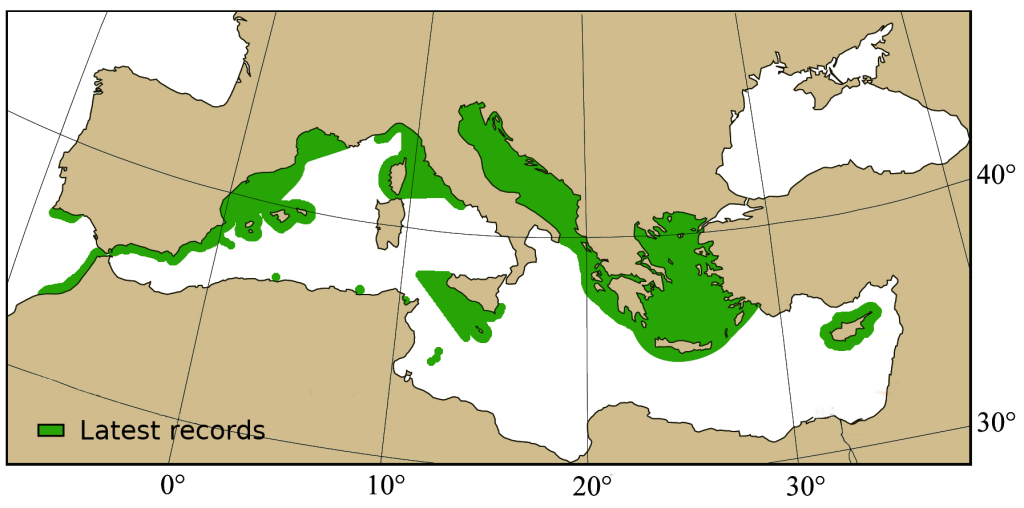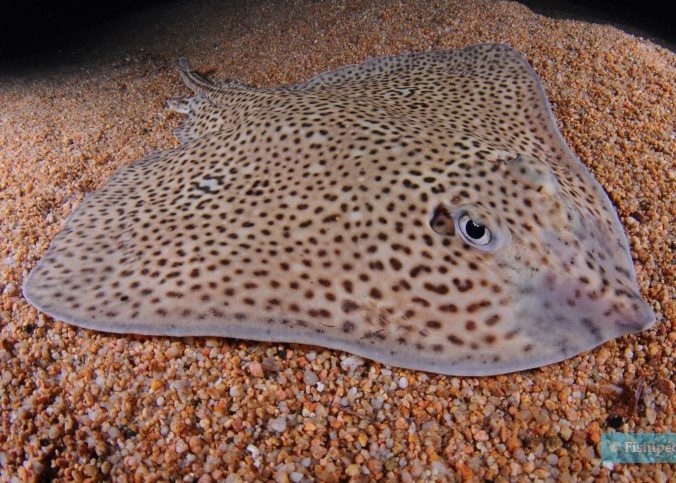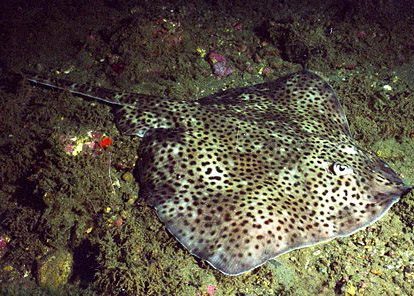Raja montagui
Common name: Spotted Skate
Order: Rajiformes
Family: Rajidae
Synonyms: None
Misidentifications: Raja polystigma, Raja brachyura
Short description
Medium sized skate. Angular disc with a circular body with pectoral fins wider than long and an edge forming a sinuous curve. Short rostrum and rounded wing-tips. Pectoral fins with clear angles on the lateral side. Triangular pelvic fins. Dorsal surface prickly in large specimens, almost smooth in young (except for bare centres of pectoral fins and hind part of disc). Separate orbital thorns. Regular row of 20-50 thorns from nape to first dorsal fin, one or two between dorsal fins and two at end of tail.
Color: Brown dorsal surface with an irregular pattern of black dots and light spots which do not reach the margin of the disc. Underside white.
Measurements:
- Total length (TL): ~60 cm (max 80 cm)
Swimming pattern: Undulatory and pelvic fin locomotion (walking and punting).
Egg case
Size: 53-78 mm length. 30-50 mm width.
Distinctive features:
- Length up to 75 mm
- Width up to 40 mm
Raja: Long posterior horns. Anterior horns length less than twice the posterior.
Rajiformes / Rajidae: RRectangular egg-case, width no greater than twice the capsule length.

Biology / Ecology
Adults feed on crustaceans and fishes. Juveniles feed on small crustaceans.
Reproduction: Oviparous. Size at birth (TL): 8-12 cm. Eggs per year: 24-60. Embryos develop in 5 to 6 months. Size at maturity (TL): ~40 cm males, ~60 cm females.
Habitat: Demersal on sandy and muddy bottoms. Adults also common further offshore on sand and coarse sand-gravel substrates. Depth: up to 650 m (more common around 100 m). Possibly occurs down to 800 m deep.
Mainly misidentified with R. polystigma. Observations now often recorded as R. cf. polystigma.
Distinguishing characteristics
- Black spots do not reach the border of the pectoral fin, contrary to R. brachyura.
- Frequently large dark spots on each middle pectoral fin.
- Regular row of 20–50 thorns from nape to first dorsal fin, one–two thorns between dorsal fin.
Rajiformes / Rajidae: Depressed body. Circular to rhombic disc. Tail well demarcated from disc.
Distribution
Worldwide: Atlantic from south of North Sea to Morocco; Mediterranean Sea. Absent from Black Sea.
Mediterranean:
- Occurrence: More common in the Western and Western Central Mediterranean Sea. Rare in the eastern Levantine basin.
- Latest records: Portugal (1986-2017), Atlantic – Morocco (2016, with juveniles), Argosaronikos, northern and southern Aegean Sea (2012-2015), Balearic Sea (2012-2015), Corsica-France (2012-2015), Cretan Sea – Greece (2012-2015), Cyprus (2012-2015), Ligurian, northern and central Tyrrhenian Sea – Italy (2012-2015), Northern Alboran Sea (2012-2015), Strait of Sicily – Italy (2012-2015), Gulf of Lion – France (2013), Catalan Sea (2013), Izmir and Sigacik bay -Turkey (2007-2009), Greece (2008), Adriatic Sea (2005), Malta (2003), Calabria – Italy (2000).

Any recent observation not on the map?
Contact us!
Conservation
Threats: Taken as bycatch in trawl fisheries.
Protection level:
- Mediterranean: Least Concern (IUCN 2016, last assessment: 2016)
- Europe: Least Concern (IUCN 2015, last assessment: 2015)
- Global: Least Concern (IUCN 2007, last assessment: 2007)
Key references
- Baino R., Serena F., Ragonese S., Rey J., Rinelli P. 2001. Catch composition and abundance of Elasmobranchs based on the MEDITS program. Rapports de la Commission Internationale pour L’Exploration Scientifique de la Mer Méditerranée 36: 234.
- Cannas R., Pasolini P., Mancusi C., Follesa M.C., Cabiddu S., Hemida F., Serena F., Tinti F. 2008. Distribution, molecular systematics and phylogeography of Raja polystigma and Raja montagui in the Mediterranean. Biologia Marina Mediterránea 15(1): 188-191.
- Carpentieri P., Nastasi A., Sessa M., Srour A. 2021. Incidental catch of vulnerable species in Mediterranean and Black Sea fisheries – A review. General Fisheries Commission for the Mediterranean. Studies and Reviews 101: I-317.
- Ellis J.R., Dulvy N.K., Jennings S., Parker-Humphreys M., Rogers S.I. 2005. Assessing the status of demersal elasmobranchs in UK waters: a review. Journal of the Marine Biological Association of the United Kingdom 85: 1025-1047.
- Follesa M. C., Marongiu M. F., Zupa W., Bellodi A., Cau A., Cannas R., Colloca F., Djurovic M., Isajlovic I., Jadaud A., Manfredi C., Mulas A., Peristeraki P., Porcu C., Ramirez-Amaro S., Salmerón Jiménez F., Serena F., Sion L., Thasitis I., Cau A., Carbonara P. 2019. Spatial variability of Chondrichthyes in the northern Mediterranean. Scientia Marina 83(S1) : 81-100.
- Giovos I., Serena F., Katsada D., Anastasiadis A., Barash A., Charilaou C., Hall-Spencer J.M.,Crocetta F.,Kaminas A., Kletou D, Maximiadi M., Minasidis V., Moutopoulos D.K., Aga-Spyridopoulou R.N., Thasitis I., Kleitou P. 2021. Integrating literature, biodiversity databases, and citizen-science to reconstruct the checklist of Chondrichthyans in Cyprus (Eastern Mediterranean Sea). Fishes 6(3): 24.
- Mancusi C., Massi D., Baino R., Cariani A., Crobe V., Ebert D.A., Ferrari, C, Gordon A., Hoff G.R., Iglesias S.P., Titone A., Serena F. 2021. An identification key for Chondrichthyes egg cases of the Mediterranean and Black Sea. The European Zoological Journal 88(1) : 436-448.



